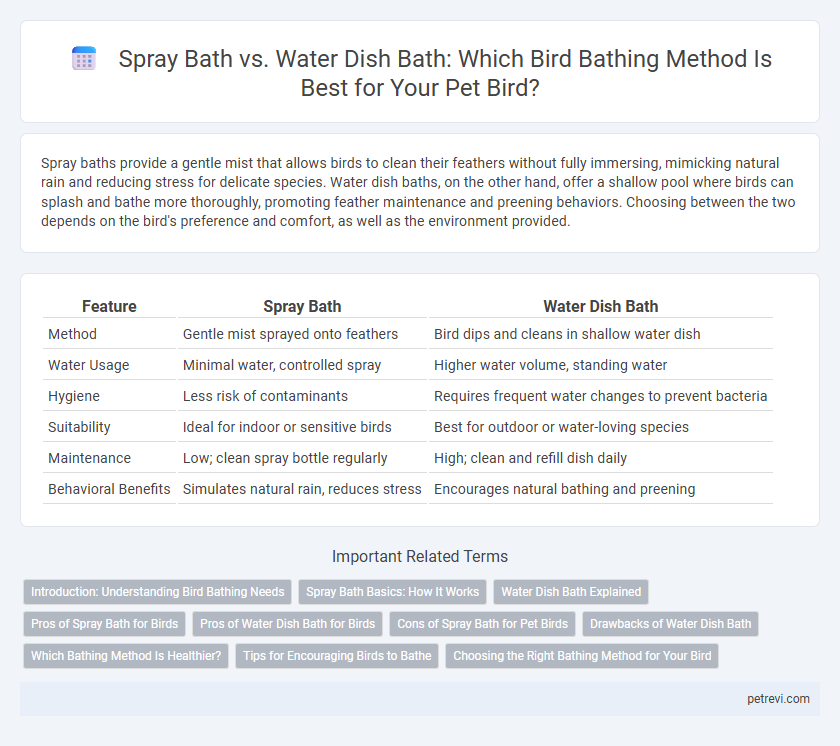Spray baths provide a gentle mist that allows birds to clean their feathers without fully immersing, mimicking natural rain and reducing stress for delicate species. Water dish baths, on the other hand, offer a shallow pool where birds can splash and bathe more thoroughly, promoting feather maintenance and preening behaviors. Choosing between the two depends on the bird's preference and comfort, as well as the environment provided.
Table of Comparison
| Feature | Spray Bath | Water Dish Bath |
|---|---|---|
| Method | Gentle mist sprayed onto feathers | Bird dips and cleans in shallow water dish |
| Water Usage | Minimal water, controlled spray | Higher water volume, standing water |
| Hygiene | Less risk of contaminants | Requires frequent water changes to prevent bacteria |
| Suitability | Ideal for indoor or sensitive birds | Best for outdoor or water-loving species |
| Maintenance | Low; clean spray bottle regularly | High; clean and refill dish daily |
| Behavioral Benefits | Simulates natural rain, reduces stress | Encourages natural bathing and preening |
Introduction: Understanding Bird Bathing Needs
Bird bathing is essential for maintaining feather health and regulating body temperature, with different species showing preferences for spray baths or water dish baths. Spray baths mimic natural rain, encouraging birds to flutter and clean their feathers more effectively, while water dish baths provide a stable platform for birds to splash and submerge. Selecting the appropriate bath type depends on understanding a bird's size, behavior, and habitat to ensure optimal hygiene and comfort.
Spray Bath Basics: How It Works
Spray baths mimic natural rain showers by delivering a gentle mist of water that penetrates a bird's feathers for effective cleaning and hydration. This method enhances feather maintenance by loosening dirt and encouraging preening without submerging the bird completely, reducing stress for many species. Spray baths use a fine water spray mechanism, often adjustable, to provide controlled moisture, making it an ideal choice for birds that avoid traditional water dish baths.
Water Dish Bath Explained
A water dish bath provides birds with a shallow container filled with clean water, allowing them to dip their feathers and splash, promoting effective cleaning and feather maintenance. This method mimics natural bird behavior, encouraging preening by loosening dirt and parasites from plumage. Proper placement in a safe, accessible location with fresh water enhances bird health and comfort during bathing sessions.
Pros of Spray Bath for Birds
Spray baths provide birds with a gentle and controlled water flow that mimics natural rainfall, which helps maintain feather condition and reduces the risk of waterlogging. They encourage natural preening behavior by allowing birds to bathe without submerging fully, promoting hygiene and parasite control effectively. Spray baths are particularly beneficial for species that prefer light misting over deep water, supporting overall bird health and comfort.
Pros of Water Dish Bath for Birds
Water dish baths provide birds with a stable and spacious platform that allows natural splashing and full-body immersion, promoting thorough feather cleaning and hydration. Many bird species exhibit a preference for water dish baths as they mimic natural puddles or shallow water bodies, encouraging instinctive bathing behavior. Water dishes also reduce water wastage compared to spray baths and can serve as a consistent water source for drinking and cooling off during hot weather.
Cons of Spray Bath for Pet Birds
Spray baths for pet birds can sometimes cause stress or anxiety due to the suddenness and intensity of the water droplets, leading to aversion rather than enjoyment. The fine mist may not effectively clean stubborn dirt or oil from feathers compared to submerging in water, potentially leaving residue that affects feather health. Frequent use of spray baths can also increase the risk of respiratory issues if moisture is inhaled excessively in confined spaces.
Drawbacks of Water Dish Bath
Water dish baths often retain debris and bacteria, increasing the risk of infections for birds. Standing water can become a breeding ground for mosquitoes and other pests, posing health hazards. The limited depth in water dishes may restrict thorough cleansing, reducing the bathing effectiveness compared to spray baths.
Which Bathing Method Is Healthier?
Spray baths promote better feather health by mimicking natural rain, effectively removing dirt and parasites without submerging birds in standing water, reducing the risk of bacterial infections. Water dish baths allow birds to immerse themselves, encouraging deeper cleaning and hydration but may increase exposure to harmful microorganisms if the water is not changed frequently. For optimal health, spray baths provide a safer, more hygienic bathing method, especially in controlled environments where water quality maintenance is challenging.
Tips for Encouraging Birds to Bathe
Providing a shallow water dish with gentle ripples attracts birds more effectively for bathing, as still water may deter them. Spray baths using fine mist simulate natural rain showers, encouraging reluctant birds to bathe by mimicking their native environment. Positioning baths near shelter and regularly refreshing the water maintains hygiene and draws more feathered visitors for regular bathing sessions.
Choosing the Right Bathing Method for Your Bird
Choosing the right bathing method for your bird depends on its species, size, and comfort level with water exposure. Spray baths provide a gentle mist that mimics natural rainfall, ideal for smaller or flighty birds, while water dish baths allow birds to splash and soak, better suited for larger or more water-tolerant species. Observing your bird's behavior during bathing helps determine whether a spray bath or water dish bath promotes the best hygiene and enjoyment.
Spray Bath vs Water Dish Bath for Bird Bathing Infographic

 petrevi.com
petrevi.com